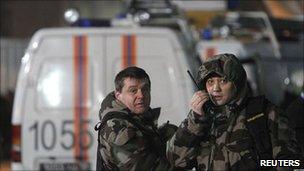Can airports be better protected?
- Published

The suspected suicide bombing at Domodedovo Airport killed and injured dozens
To those of us with a watching brief or professional association with the aviation world, a grim inevitability surrounded the events that unfolded at Domodedovo airport on Monday afternoon.
The past quarter century has seen a string of attacks against airports, as well as the aircraft operating from them.
It was only a matter of time before a suicide attacker targeted a major airport and caused the sort of carnage witnessed at Domodedovo.
Such an event could just as easily happen at almost any other airport in the world with the same horrendous consequence, and is a problem that has long taxed the minds of security professionals the world over.
Airports are public transport hubs and this implies relatively unfettered access.
Profiling techniques
President Dmitry Medvedev spoke about the need for Russian airports to adopt Israeli-style security procedures. But this presupposes that Ben Gurion methods can be scaled up to accommodate operations at Domodedovo.
Ben Gurion - Israel's main international airport - is frequently held up as a shining example of how best to secure airports, but its security arrangements simply cannot work in much larger airports.

Russian officials stepped up security at all of Moscow's transport hubs after the explosion
We cannot turn airports into no-go zones for anyone other than people with a reservation and a boarding pass, since the global aviation system would simply grind to a halt. So how can we deliver better protection in light of Monday's events?
Lessons can learned from Israel in terms of much greater application of behavioural analysis and profiling techniques, but supported by advanced non-contact screening technology.
Intelligent computer technology that recognises suspicious behaviour in live internet-enabled CCTV feeds from public transport systems linking into our airports is already a reality.
This is thanks to groundbreaking work - supported by the UK Home Office - carried out by the Centre for Secure Information Technologies (CSIT) at Queens University in Belfast.
Meanwhile, experts at Loughborough University have developed an Explosive Residue Detection (ERD) system said to deliver a step change in our ability to detect explosives on people and items of luggage.
This laser-based device can be installed at airport entry points and can accurately identify trace amounts of explosive on travellers or visitors passing through.
These two technology solutions could deliver an extended airport security perimeter and afford much better protection to all those who use our busiest transport hubs.
Such radical changes obviously demand imagination on the part of those who deploy security measures, the wherewithal to fund them, and the political will to enhance the security afforded to both the travelling and non-travelling public at airports.
Many of us associated in minor or large part with the aviation industry would suggest that the time for such radical change is upon us.
- Published25 January 2011
- Published25 January 2011
- Published24 January 2011